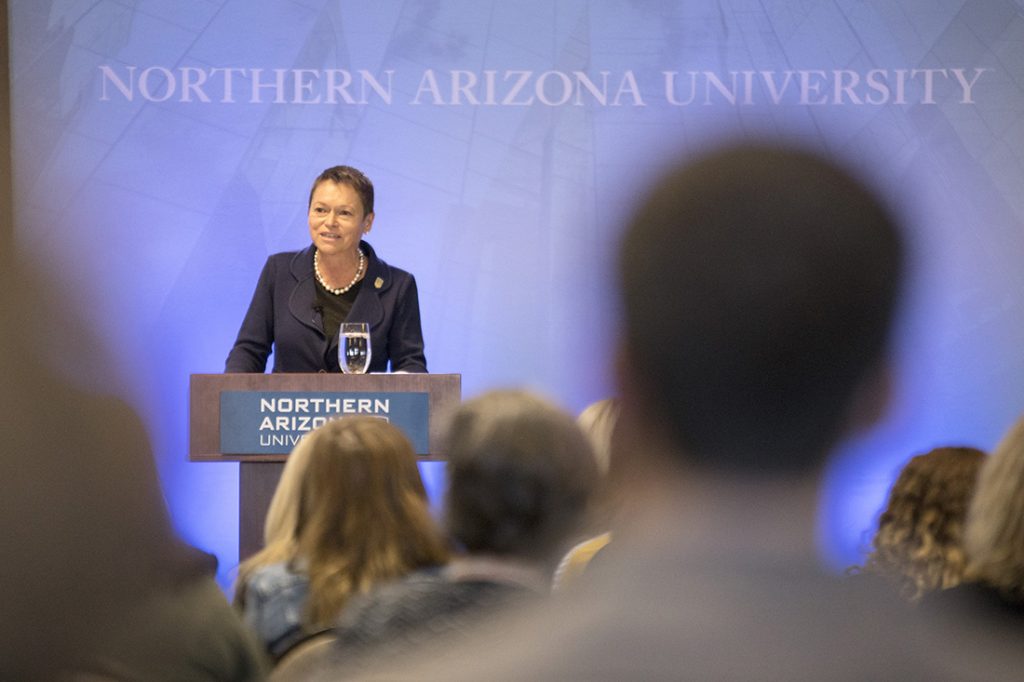During the spring campus forum this week, Northern Arizona University President Rita Cheng pointed out many of the ways the university is nationally recognized and locally vital, along with laying out details of a strategic plan that will help NAU continue to build its reputation and research output.
“I have heard from many members of the NAU team that our university’s reputation is expanding—around the state, around the country and around the globe,” Cheng said.
She noted that higher education institutions throughout the nation are facing challenges from many directions, but NAU is taking proactive steps to ensure the university remains a place where students can get a quality, affordable education that prepares them for future jobs and faculty and staff members can reach their potential.
“The investments we make, the opportunities we pursue are all centered on the service we provide in our roles as stewards of this university,” she said. “We meet each challenge with confidence, and together we chart a course to lead in high-quality, student-focused education.”
Cheng also shared the five goals of the strategic plan, which is the result of collaboration around a shared vision from every corner of the campus. She thanked those who worked on the plan, as well as the university’s employees for all they do in helping NAU students achieve success.
“This plan challenges us to coordinate our operations with our long-term goals in mind, so every day we move forward,” Cheng said. “Each of you is an essential part of our progress and success.”
The Campus Forum is available to watch in its entirety online on NAU-TV.
The first goal is the priority that has shaped NAU’s reputation: student success and access. Cheng said NAU will continue to increase access to higher education and help Lumberjacks reach their goals.
“In the coming year NAU will evaluate improve coordination of and consider the effectiveness of our interventions and assistance program as we help our students on their educational journey.”
The intellectual curiosity that leads students to NAU is the foundation for the second goal: research and discovery. NAU researchers are working to expand the boundaries of knowledge and creativity. The team generates $46.3 million in funded research expenditures and public service projects generate $32.6 million. That research and public service funding has led to 46 invention disclosures and thousands of students with hands-on experience in the quest for new knowledge and the desire to continue that innovation as they go onto graduate programs or start jobs.
The third goal of the strategic plan is outreach to Native American students. Native American communities have always been a priority for NAU, Cheng said. The aim is to be the nation’s leading university serving students who are Native American, Alaska Native and Native Hawaiian.
More than 2,100 such students are enrolled at NAU now, and the university continues to build partnerships to reach many more. The university’s programs will continue to reach across cultural and linguistic divides to connect to students from every area of Arizona.
Cheng said she is proud of the many ways NAU impacts every corner of Arizona, but also pointed to room for growth through the fourth goal: engagement. She wants to enhance the strong ties between NAU and the communities served and said the university will continue to align its programs with local workforce needs to create more opportunities for our students.
The fifth and final goal of the strategic plan is to be even better stewards of the university and its resources. This goal requires action across many areas of operations, and it means the university must adapt to be more efficient and use resources wisely to ensure NAU can continue to accomplish its mission.
“We know where we want to be—the impact we want to have in our state, the knowledge we want to create and enhance and the learning outcomes we want for our students,” Cheng said. “But it is not enough to know the end point—we must align our efforts and strategies to achieve our goals. This plan challenges us to coordinate our operations with our long-term goals in mind, so every day we move forward.”



